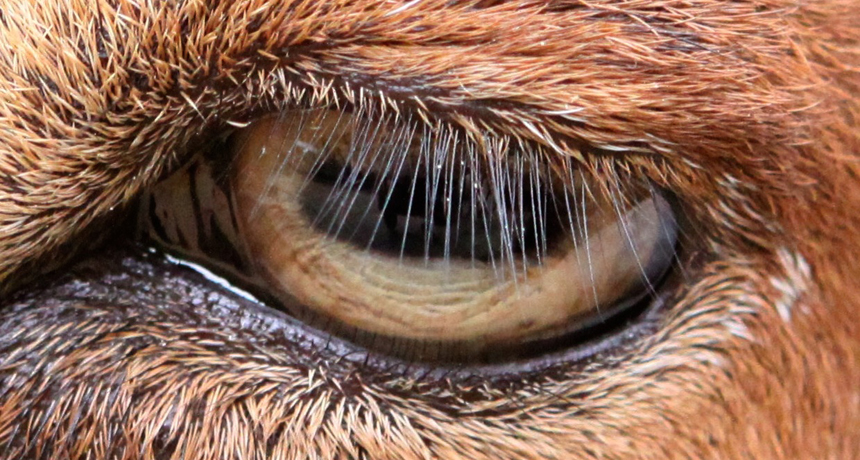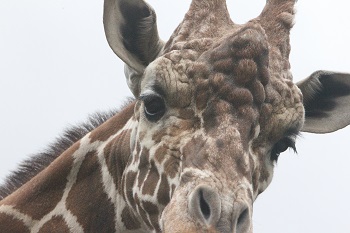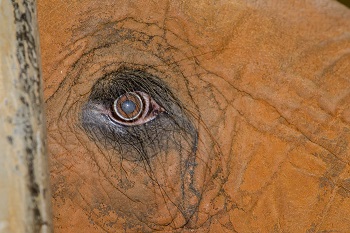Eyelashes: The ‘sweet’ length
Overly long lashes could sabotage their ability to protect the eyes, research shows

This goat has eyelashes that fall in roughly the “sweet spot” for length and protection: roughly one third of an eye’s width.
G.J. Amador et al./Journal of the Royal Society Interface 2015
By Susan Milius
Cosmetics commercials extoll the virtues of long, luxurious eyelashes. They even sell products to make them longer. But, new research indicates, in terms of eye health, long isn’t always better.
There’s a so-called “sweet spot” in the range of lash lengths. It is about one-third the width of the eye. And it’s here that lash length appears most helpful. Eyelashes much longer than that will funnel airflow — and grit — into the eye, instead of deflecting about half of it, finds David Hu. He works at the Georgia Institute of Technology in Atlanta. There he studies how the shape of an animal’s body affects how air flows across its parts. Lashes that are too short can present their own problems. Stubby, little ones won’t offer the eyes enough protection.
These ideas come from new research. It started with tests in special, small-size wind tunnels. Hu’s team then used these data in mathematical simulations, known as computer models, to evaluate the benefits of various length lashes.

Hu and his colleagues reported their findings February 25 in the Journal of the Royal Society Interface.
Research inspired by a baby’s face
The idea for Hu’s project came while he was admiring his baby daughter’s long lashes. It set him wondering about eyewear elsewhere in the animal kingdom. To see what Mother Nature offers, he sent a student to measure lash length in animals. The student took those measurements in a basement full of pelts at the American Museum of Natural History in New York City and at a taxidermy center.
Why not study lashes on live animals? “If you bring sharp instruments like measuring instruments near animals’ eyes, they get annoyed,” Hu explains.
Lash lengths were surveyed for 22 species. These mammals ranged from hedgehogs to giraffes. In most cases, lash lengths came in at around one-third of an eye’s width. That’s within the range that a computer model had suggested would be the best for giving eyes some protection as air flows across the face of an animal moving forward. “The eye is a wet organ,” Hu explains. Too much air could dry out the tissue and also raise the risk that dust and debris might blow in.
To test real-world airflow, “We decided to build a miniature wind tunnel for eyelashes,” Hu says. A tiny fan from a computer created a gentle breeze. A small lab dish of water represented the vulnerable moisture of the eye. Without any lashes, the water evaporated about twice as fast as it did when surrounded by a little fringe that looked like straight eyelashes.
Biologists also have mused about how lashes might protect against airborne bits of grit bombarding the eye. So Hu and his colleagues loaded a home humidifier with dyed water and gently blew a green mist of microscopic droplets at their pretend eye. The experiment showed that right-sized lashes deflected about half of the incoming particles.
Borrowing from Mother Nature
Eyelashes do snag some bits, Hu notes. Much of their benefit, however, comes from guiding air — and sending any particles in it — away from the eye. One advantage: These air guides may not require as much cleaning as solid barriers or as frequent replacement as dust-trapping air filters.

Artificial lashes might one day even ease the widespread human misery of dry eye, Hu suggests. This idea sparked both interest and caution from Richard Braun. He’s a mathematician at the University of Delaware in Newark who studies the outer film of moisture covering eyes.
That film can vary by more than 20 times in how well it protects the eye from drying out, he says. The right lashes might boost that protection. Still, Braun notes, when it comes to treating dry eye, “There are a host of other factors that may be more significant.”
Power Words
(for more about Power Words, click here)
aerodynamics A study of how gases flow around objects.
computer model A program that runs on a computer that creates a model, or simulation, of a real-world feature, phenomenon or event.
dry eye A condition that develops when the eye cannot produce enough tears to keep its surface adequately moist. Too little moisture can cause the eye’s surface to become inflamed, scarred or develop open sores. Some vision loss could result. An estimated 5 million older adults in the United States alone suffer some form of dry eye, according to the American Academy of Ophthalmology.
engineer A person who uses science to solve problems. As a verb, to engineer means to design a device, material or process that will solve some problem or unmet need.
pelt (in biology) The furry coat of some mammal that has been removed from the animal’s carcass.
sensor A device that picks up information on physical or chemical conditions — such as temperature, barometric pressure, salinity, humidity, pH, light intensity or radiation — and stores or broadcasts that information. Scientists and engineers often rely on sensors to inform them of conditions that may change over time or that exist far from where a researcher can measure them directly.
simulate To deceive in some way by imitating the form or function of something. A simulated dietary fat, for instance, may deceive the mouth that it has tasted a real fat because it has the same feel on the tongue — without having any calories. A simulated sense of touch may fool the brain into thinking a finger has touched something even though a hand may no longer exists and has been replaced by a synthetic limb. (in computing) To try and imitate the conditions, functions or appearance of something. Computer programs that do this are referred to as simulations.
taxidermy The reconstruction of an animal, for permanent display. Skilled people model its structure on the carcass of a real animal, sometimes incorporating parts of the original animal’s carcass, such as the bones, pelt, skin, toothed jaws or fins.
wind tunnel A facility used to study the effects of air moving past solid objects, which often are scale models of real-size items such as airplanes and rockets. The objects typically are covered with sensors that measure aerodynamic forces like lift and drag. Also, sometimes engineers inject tiny streams of smoke into the wind tunnel so that airflow past the object is made visible.







